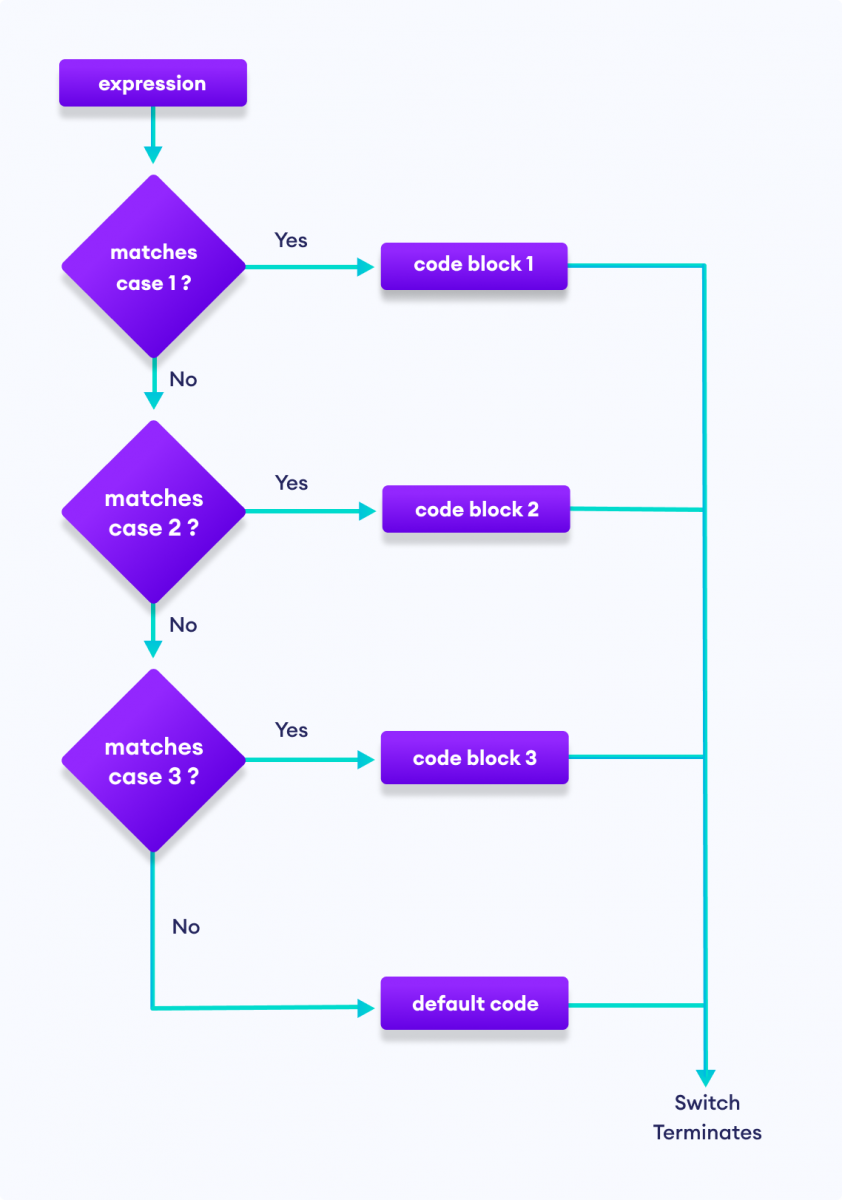The switch statement allows us to execute a block of code among many alternatives.
The syntax of the switch statement in Swift is:
switch (expression) {
case value1:
// statements
case value2:
// statements
...
...
default:
// statements
}
The switch statement evaluates an expression inside parentheses ().
- If the result of the expression is equal to
value1, statements of thecase value1:are executed. - If the result of the expression is equal to
value2, statements of thecase value2:are executed. - If there is no match, statements of the default case are executed.
Note: We can do the same thing with the if...else...if ladder. However, the syntax of the switch statement is cleaner and much easier to read and write.
Flowchart of Switch Statement

Example 1: Simple program using Switch Statement
// program to find the day of the week
let dayOfWeek = 4
switch dayOfWeek {
case 1:
print("Sunday")
case 2:
print("Monday")
case 3:
print("Tuesday")
case 4:
print("Wednesday")
case 5:
print("Thursday")
case 6:
print("Friday")
case 7:
print("Saturday")
default:
print("Invalid day")
}
Output
Wednesday
In the above example, we have assigned 4 to the dayOfWeek variable. Now, the variable is compared with the value of each case statement.
Since the value matches with case 4, the statement print("Wednesday") inside the case is executed, and the program is terminated.
Switch Statement with fallthrough
If we use the fallthrough keyword inside the case statement, the control proceeds to the next case even if the case value does not match with the switch expression. For example,
// program to find the day of the week
let dayOfWeek = 4
switch dayOfWeek {
case 1:
print("Sunday")
case 2:
print("Monday")
case 3:
print("Tuesday")
case 4:
print("Wednesday")
fallthrough
case 5:
print("Thursday")
case 6:
print("Friday")
case 7:
print("Saturday")
default:
print("Invalid day")
}
Output
Wednesday Thursday
In the above example, since the value matches with case 4, the statement print("Wednesday") inside the case is executed
We have also used the keyword fallthrough. So, the statement print("Thursday") inside case 5 is executed even if the case doesn't match with the case statement.
Example 2: Switch Statement with Range
let ageGroup = 33
switch ageGroup {
case 0...16:
print("Child")
case 17...30:
print("Young Adults")
case 31...45:
print("Middle-aged Adults")
default:
print("Old-aged Adults")
}
Output
Middle-aged Adults
In the above example, instead of a single value, we have used numeric ranges for each case: case 0...16, case 17...30, and case 31...45.
Here, the value of ageGroup is 33 that falls under the range 32...45. Hence, the statement print("Middle-aged Adults") is executed.
Tuple in Switch Statement
In Swift, we can also use tuples in switch statements. For example,
let info = ("Dwight", 38)
// match complete tuple values
switch info {
case ("Dwight", 38):
print("Dwight is 38 years old")
case ("Micheal", 46):
print("Micheal is 46 years old")
default:
print("Not known")
}
Output
Dwight is 38 years old
In the above example, we have created a tuple named info with values: "Dwight" and 38.
Here, instead of a single value, each case statement also includes tuples: case ("Dwight", 38) and case ("Micheal", 46).
Now, the value of info is compared with each case statement. Since the value matches with case ("Dwight", 38), the statement print("Dwight is 38 years old") is executed.
To learn more about tuples, visit Swift Tuple.